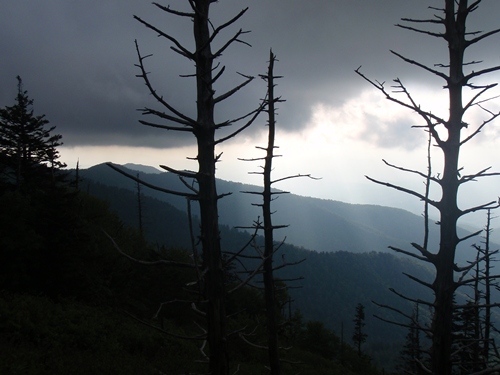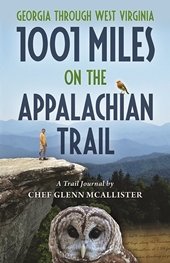Groundhog Creek Shelter to Standing Bear Farm, 7.2 miles
JUNE 11
I had an extra supper in my bag, so I cooked turkey with mashed potatoes and mixed vegetables for breakfast. The brothers-in-law left in light rain, but soon it was pouring. Two men who had camped near the shelter got caught in the downpour as they were taking down their tents. They holed up with me in the shelter and spread their tents out to dry. One of them called his wife to ask if she could give him a weather report. She called back and said the rain would stop at eleven o’clock followed by partly cloudy skies with rain returning at three o’clock.

The rain stopped on schedule, and I hit the trail. I gained twelve
hundred feet in elevation over the first two miles up to the bald at
Snowbird Mountain. The view was hazed over with clouds. There was a
funky-looking FAA radio tower at the top. It was all white. The office
had a flat round roof, like a big plate was sitting on it, and on top of
that, the tower was shaped like a giant bowling pin. From there, it was
downhill the last five miles to Standing Bear Hostel. The latter part
of the weather forecast was also accurate: at three o’clock it poured,
soaking the insides of my boots again. Alongside the gravel road leading
to the hostel, a creek churned furiously and overflowed its banks.
Pizza
was coming out of the oven when I got to Standing Bear Hostel. Vincent,
the caretaker, handed me a slice and gave me a tour during a break in
the rain. The compound’s buildings—rustic, tin roofed, built with
rough-hewn lumber and poles—were from a century-old farmstead.
Everywhere was evidence of an artist and craftsman working with his
hands behind the scenes—wagon wheels and rusty farm implements, rock
gardens, log benches arranged for fellowship. There was a well-stocked
commissary for backpackers. I dropped my gear in the bunkhouse and
washed clothes—the old-fashioned way—with a washbasin, washboard, and
wringer behind the camp kitchen.
With little warning, a cauldron
of brown-and-gray clouds swirled over the compound and unleashed a
deluge of sideways rain. It felt like tornado conditions, but it passed
quickly. I took a ride with Vincent to a convenience store for a BBQ
sandwich and chocolate milk.
Back at the hostel, I sat at the
kitchen table with Vincent and three young hikers, playing the house
guitar, which was missing a string. A pop-top served as a pick. We
passed the guitar around since everybody could play. One hiker, Forager,
said he ate snails on the trail and suggested it was best to cook them
in their shells. He wasn’t called Forager for nothing. Light on money,
he had been staying at Standing Bear for the past week under a
work-for-stay arrangement. I went to the bunkhouse a few hours after
sundown.
Next Day: Enter Great Smoky Mtn. Nat. Park
Standing Bear Hostel to Tricorner Knob Shelter
Previous Day:
Walnut Mountain Shelter to Groundhog Creek Shelter
Table of Contents:
Share this page with friends on social media.








